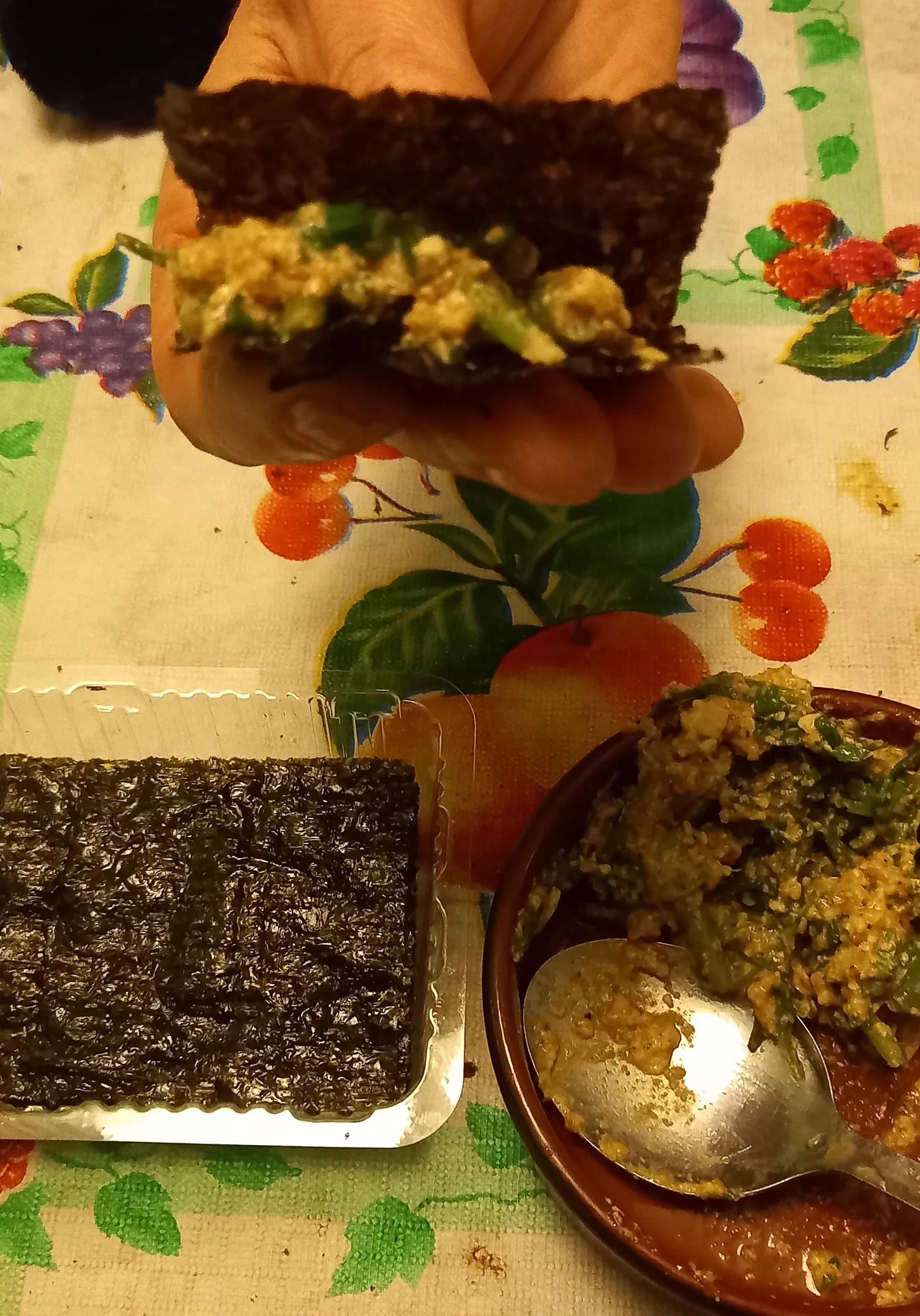March 19, 2023. Waterlooville, Hampshire, United Kingdom: inside my refrigerator. Taking stock of today’s necessities—Yogurt? check. Creme fraiche? check. Chutney, milk, jam, pickled peppers? Check, check, check. And…looking ever so lush and succulent, a big bouquet of chrysanthemum leaves, sitting in a glass of fresh cool water. Check.
Below are the greens in the shop. I had to sneak around to take the photo, and still, the woman caught me and started yelling, and its possible she is still yelling at me now, days later—that’s how irate she was, though really: why? Anyhow, the chrysanthemums are the ones covered with plastic, to help keep the leaves from drying out.
Chrysanthemums refer to the Garland chrysanthemum, also known as Tong Hao in China, Shingiku in Japan, and Tan O in Vietnam. The leaves are tender, the stalks fibrous; the taste at once grassy and herbacious, yet slightly bitter, a bit like mustard greens (The longer the leaves stay on the plant the more bitter their bite. They are extremely popular in cuisines throughout Asia; in hot pot, soups, stir fries, relishy salads, fritters/tempura, sukiyaki or bulgogi. I’m thinking of making a salad of chrysanthemums, fuyu persimmons, and a creamy/pungent blue cheese.
As in so many Asian cultures, the medical benefits of specific foods are lauded, proclaimed loudly: so many vitamins and minerals and other health-giving substances! According to Google, each bite brings you closer to your most healthful self; plus you can steap the leaves for tea. (Though I think I can feel them doing me good, the truth is that I eat them because I like their taste—no, make that love, I LOVE their taste! )
The first time I ate chrysanthemums leaves, that is, the first time I took a bite and was wowed, exclaiming (screaming really, though silently to myself) WHAT IS THIS? was in Japan.
I was with a small group of food writers, in a Tokyo Izakaya, guests of the utterly charming, chirpy, Harumi Kurihara, television chef, lifestyle guru and enthusiastic eater. She kept ordering different dishes for us to try, along with endless glasses of refreshing beer. More dishes, more tastes, more beer, all appearing in a delicious parade of small plates.
By now we were all exclaiming (possibly drunkenly?) about the super umami-rich dip/spread of herby leaves smashed with tofu and sesame seeds, into a sort of dip or spread.
I may have been the one exclaiming the most loudly: it was so delicious, and yet: what was it? I couldn’t place the vegetable by its taste or scent. It tasted vaguely familiar, but not like something I had ever eaten. A few bites in, I realized they tasted like the garden smelled, of the chrysanthemums that lined our walkway.
Sitting around the long table, Harumi gave us each a gift of a little suribachi, a traditional grinding bowl, or a mortar and pestle for grinding things like, well, sesame seeds. In the Japanese kitchen, sesame seeds are often hand-ground, and the suribachi makes it easier and quicker than other types of mortar and pestles, and more fragrant with a more satisfying texture than using a blender or food processor which doesn’t work so well in any event—the blade chases the seeds around and around, without giving them the proper smashing.
So if you want to grind sesame seeds, whether finely ground or a coarse meal, you probably want a suribachi. Not only does it do the job so well, it is so satisfying: especially as the scent of the sesame seeds as they are crushed by the mortar rises up and your kitchen begins to smell like Japan, or Korea, or wherever beautiful sesame seeds are part of the flavor landscape. However you are going to be using it, know that you don’t need to do much: once your seeds are coarsely ground, add a little seasalt and pound it in with the sesame, for the classic sesame salt, gomacio. If I’m pounding sesame seeds, I’ll usually do a little bit extra just so that I always have gomacio on hand: for rice, for salads, for noodles, fish, or potatoes, even to add to mayonnaise or aioli.
Shingiko Goma-ae/Japanese Chrysanthemum Tofu Spread Wrapped in Seaweed
The chrysanthemum flower is revered in Japanese culture, a symbol of long life, and for the royalty of the imperial family—it is pictured on Japan’s Imperial Seal. One of the five ancient sacred festivals is national chrysanthemum day.
Big bunch of chrysanthemum leaves, tough stems cut off
3 tablespoons (about) white sesame seeds (or, if already toasted, omit this step from the recipe).
2 oz soft tofu
1 teaspoon sesame oil
1 teaspoon soy sauce
Salt to taste
Sugar to taste—about 1/2-1 teaspoons
About 1-2 tablespoons peanut butter/almond butter/Chinese sesame paste
Seaweed snacks, for wrapping around the mixture, sandwich-like
Cut the chrysanthemums into bite sized pieces and blanch for no more than 30 seconds. Remove from the hot water, place in ice water, let cool, then drain and pat/blot dry. Set aside.
Toast the sesame seeds until lightly golden, then allow to cool for a few minutes. Place in the suribachi, and coarsely crush the seeds until they form a sort of meal texture.
Crush/puree/mash the chrysanthemum leaves with the soft tofu, and sesame seeds, and when it forms a fluffy paste, add the sesame oil, soy sauce, salt and sugar, then work in the nut butter/sesame paste of choice.
Serve in a small bowl with a stack of crisp seaweed wafers as dippers.
Spicy Chinese Chrysanthemum Leaf Salad
I can’t emphasize how delightful this salad is. That its super easy, super simple, is true as well. Steamed rice, rare grilled meat, sliced raw daikon, all are good alongside. In fact, I almost can’t think of anything that wouldn’t be.
1 nice big bunch chrysanthemum leaves, tough stems removed, cut into bite sized pieces
2-3 cloves garlic, grated
knob ginger, about same amount in volume as the garlic, grated
2-3 tablespoons Chinese black vinegar
2-3 tablespoons soy sauce ( preferably light soy)
1/2 teaspoon each salt and sugar, or to taste
1/4 cup bland vegetable oil
2 tablespoons chile crisp
Wash and blot-dry the chrysanthemum leaves, then set aside.
Combine the garlic with the ginger, black vinegar, soy sauce, salt, and sugar. Set aside.
In a small saucepan or heat proof bowl, heat the oil in either a microwave or stove top until it just begins to smoke, but doesn’t boil or get scary. Remove from heat, and carefully, so that it doesn’t splash back onto you and give you a nasty burn, add it to the liquid vinegar-soy sauce mixture. Stir for it to combine. When its mixed well, add the chile crisp and stir well together.
Pour over the chrysanthemum leaves and serve right away.
Chrysanthemum Leaf Soup
Add a handful of the raw, trimmed, washed and dried leaves to a bowl of hot noodle soup—that’s it, thats the recipe.
The soup we ate our chrysanthemum leaves in yesterday was thin, thin noodles, shiitake mushrooms, puffy fried tofu, dense 5 spice tofu, stock or bone broth, and soft tofu.
Just before you serve it, add a big handful chrysanthemum leaves, then drizzle with sesame oil and light soy sauce, chopsticks and fat slurping-spoon at the ready.









please check local poison control, or agricultural advice, I don't want even a single hair harmed on your lovely head! Also: don't overcook the chrysanthemums, when they overcook they can be ruined! (i've had experience in this). so if you're adding to a stir fry, add at the end, like you would bean sprouts, or herbs. like, cook them for under half a minute?
ah, Oh Nancy, the lady was so angry! and i don't understand because I have always thought so fondly of the shop, and the people in it. However, i think its her parents who like me, she just seemed angry in general, and maybe worried I would steal something by taking photos! "Its forbidden!". even when i tried to tell her how much we loved the purple sweet potato noodles she recommended to me last time...at least she didn't grab my phone, like the peeps in that pastry shop in marrakech!